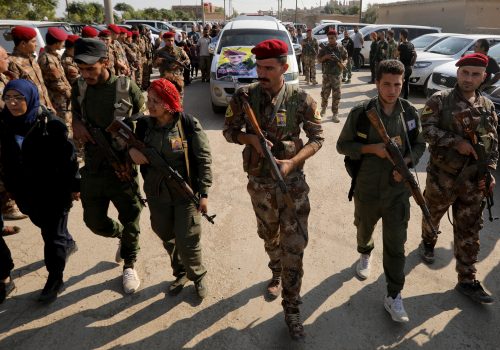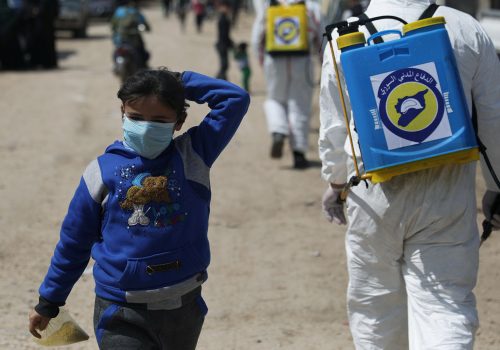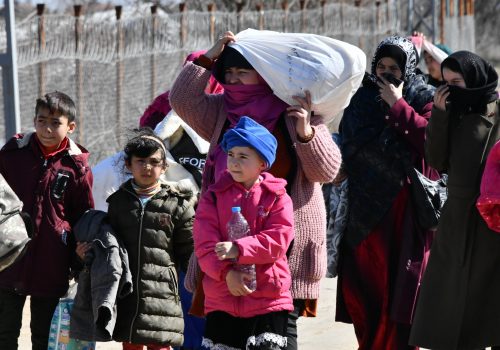The Syrian online war of narratives
Narrative in the Syrian Civil War acts as a front contested with unprecedented means over an unprecedented scale. It is fueled by technology and waged by analysts, human rights advocates, a burgeoning civil society, and the conflict’s many factions, who are all locked in competition to shape the historical record.
The importance of narrative in Syria coincides with an era of rapidly evolving digital media and information warfare, which is becoming a near universal staple of contemporary armed struggle. As scholars of active measures like Dr. Thomas Rid have noted, politicizing information is nothing new, but the digital age has opened the way to something entirely “more active and less measured.”
Today, audiences can be reached over a vast gamut of online media platforms—such as Twitter, Facebook, and YouTube—where human interaction can be stimulated with algorithms or simulated with bot networks. While such dynamics allow disinformation to spread faster than ever, open source investigation tools have also democratized fact-checking. Together, these developments have precipitated a growing understanding that modern media is contested by partisans, but have left frustratingly few means to evaluate the scope or impact of their activities.
Thus, the arms race between information and disinformation has become integral to the Syrian conflict, where narrative control is a means to securing sponsorship from foreign powers, receiving arms and air support, ensuring the enforcement or abandonment of red lines, and guaranteeing the recognition or rejection of war crimes.
Syria’s high-profile narrative front
The highest profile cases of Syria’s online narrative war are dominated by headline-grabbing events, such as allegations of war crimes, which raise international attention and draw out overt statements from the conflict’s major parties. The usage of chemical weapons is an example of this kind of inflection point—a case where determining culpability and the extent of civilian casualties shapes perceptions of villain and victim, as well the appetite for international military intervention.
At several junctures in the conflict, both the United Nations and a fact-finding mission from the Organization for the Prohibition of Chemical Weapons (OPCW) have held the regime of Bashar al-Assad responsible for chemical attacks. In response, the Russian government has rejected the findings of the mission and presented a counter-narrative blaming the opposition for the use of chemical weapons.
By December 2019, Russian objections were supported by two dissident members of the OPCW team, made public through WikiLeaks, an international non-profit that claims independence despite allegations of cooperation with Russian authorities. In February, the OPCW stated the dissident team members had little direct access or role in the investigation, but not before the story achieved wide circulation. The parallel efforts of open source investigators like Bellingcat added yet another non-state actor to the fold, where their researchers detailed the culpability of the Assad regime and, in turn, became the subject of official Russian condemnation and alleged cyber-attacks.
For their dual role in documenting and treating casualties of chemical attacks, as well as other forms of indiscriminate violence against civilians, Syrian healthcare workers have also become magnets for narrative controversy. In particular, the volunteer rescue personnel of Syria Civil Defense, known popularly as the “White Helmets,” have achieved international notoriety and become yet another inflection point in Syria’s online narrative war.
Traditional press outlets like The Guardian, joined by opposition-sympathetic advocacy groups, like the Syria Campaign, accuse Russia and the Assad regime of leading a coordinated disinformation effort against the White Helmets. Such sources describe a campaign which combines state media, fringe anti-western pundits, and covert action across social media outlets—a campaign which notably spikes in activity after headline-grabbing events occur, like chemical attacks or the Nobel prize nomination of the White Helmets’ founder.
As of 2018, the Syria Campaign credits the disinformation effort with reaching an estimated fifty-six million people and pushing hashtags like #Syria Hoax to the top of Twitter in the United States. Narrative manipulation of this scale is enabled by the relative dominance of Russian, Iranian, and Assad regime sources in social media engagement. Through disproportionately investing in networks of media outlets, pro-regime narratives are more rapidly spread and achieve greater visibility than countervailing information from independent or western media sources.
This pattern of high-profile narrative contestation also works beyond social media and journalism. In film form, Syrian documentaries like 2017 Academy Award winner The White Helmets and 2019 nominees The Cave and For Sama (also a 2019 BAFTA winner)introduce the plight of Syria’s besieged civilians and healthcare workers into popular entertainment award shows. By reaching such audiences, Syrian documentarians raise global understanding of their perspective far beyond the effect of dueling government press-releases. In response, regime supporters often structure their counter counter-narrative around discrediting the filmmakers and the human subjects of their documentaries.
In an overt example from 2017, the official account of the Russian Embassy in London accused the victims and first responders profiled in The White Helmets of having been paid actors. The embassy’s posts were accompanied by a cartoon of an Osama Bin Laden-esque figure in a white helmet accepting an Oscar statue.
After their Academy Award nomination and BAFTA win, the central figures of For Sama received similar treatment when Dr. Hemza al Khatib, a focal point of the documentary, was accused of affiliation with jihadi war criminals. The counternarrative was supported by a series of images circulating between pro-regime accounts and even those linked to the Kurdish-led Syrian Democratic Forces in the case of the organization’s press office head Mustafa Bali. Despite evidence of relatively crude manipulation among the photos, they were spread throughout social media.
The online narrative war “kicker”
For all the importance of understanding Syria’s online narrative war, there is a maddening sense that analytic measurement falls short. True, the phenomenon of disinformation is being scrutinized by hard-hitting research. Efforts to identify journalists with partisan agendas hint at the scale of a wider problem. Much ink has been spilled over the phenomenon of partisans trolls or bots. It has likewise been established that states actively shape narrative over digital media. However, the question remains, for all the energy invested into this new age of information warfare, where is it actually effective? Frustratingly, states and independent researchers alike struggle to produce concrete answers.
In the wake of strikes against the Assad regime in 2018, the US Department of Defense estimated a 2,000 percent increase in Russian-Iranian disinformation activity, a figure that the best efforts of the Atlantic Council’s Digital Forensic Research Lab have been unable to corroborate. The latter institution, along with Bellingcat, have gone to great lengths to elucidate this prevailing fog of war, noting the high burden of proof required to separate genuine and ingenuine activity on social media.
Similarly, international media outlets have greatly increased coverage of disinformation related to “Russian troll” activity. Unfortunately, even well-resourced organizations like the New York Times have blundered by misidentifying rarely-read bloggers as major actors in state-sponsored disinformation networks. Particularly confounding, the work of active measure scholars like Dr. Rid have demonstrated that both disinformation’s perpetrators and fact-checkers lack effective means of measuring its effect on public opinion.
Understanding these shortcomings should by no means obscure the importance of information warfare, which has been credibly linked to altering international perception of conflicts like Syria. The issue is rather, while high-stakes battles over narrative are ongoing, misidentification or misuse of terminology further muddies already murky waters. When coupled with the lack of clear-cut metrics for evaluating impact, a perfect recipe for both over and underestimation of the situation abounds—an uncertainty that silences victims and aids the work of disinformation’s perpetrators.
Karl Nicolas Lindenlaub is an independent researcher with a thematic focus on asymmetric warfare, security force assistance, and sub-state militant groups. Follow him on Twitter: @KNLindenaub.
Image: Naser, a 12-year-old boy, sits with Free Syrian Army fighters as they watch a video clip on a computer at a safehouse in Maarshmarein village, in the countryside of Maaret al-Naaman, in Idlib April 1, 2014. According to the Free Syrian Army, Naser assists with the general upkeep of the safehouse. REUTERS/Khalil Ashawi


